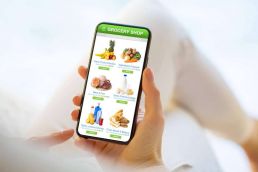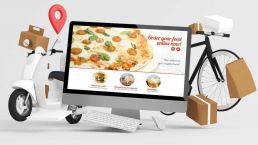The Delivery Marketplace Apps Builder
Start strong with an all-in-one platform offering more than 86 features
Client App, Client web site, Delivery App, Vendors App, Admin panel, Push Notifications, Tracking, Loyalty system and more

The Delivery Marketplace Apps Builder
Start strong with an all-in-one platform offering more than 86 features
Client App, Client web site, Delivery App, Vendors App, Admin panel, Push Notifications, Tracking, Loyalty system and more


Fully customizable
The platform is fully customizable under your brand and needs, we will help you in every step
Powerful Features
Order, Preorder, Click & Deliver, Click & Collect, Push Notification, DeliveryTracking, Cash tracking, Loyalty, ePayment, Mobile payment, Coupons, Analytics, Automation, and more
Optimize your resources
Start quickly and strong without heavy investment, our pricing is based on accessible setup costs and a monthly subscription
How to Build an UberEats Clone App: Features, Cost, and Development Process
The concept of food delivery throughout the world has transformed so much that it’s made ordering food a lot easier now. The way older people used to order food has been long gone ever since on-demand delivery applications emerged.

In this article, we will delve into the intricate process of creating an UberEats clone app, exploring the essential features it should encompass, estimating the associated costs, and deciphering the step-by-step development journey. Whether you’re a budding entrepreneur looking to venture into the world of on-demand food delivery or a seasoned developer seeking insights into the app development process, our comprehensive guide will provide you with valuable insights to navigate the complexities of building your very own food delivery platform.
Tables of Content
Mastering the UberEats Ecosystem: From Understanding to Building
Understanding UberEats and Its Features Build an app like Ubereats: Planning and Research Build an app like Ubereats :Key Features and Functionalities Development Process: Building an App Like UberEats
From Scratch Development Fully Customizable Platform Development
Developing From Scratch Ready-Made Platform Subscription Testing and Quality Assurance for UberEats Clone App Development
Comprehensive Testing Approach Importance of Quality Assurance (QA)
Pre-launch Preparation Create Hype and Anticipation Launch Day Strategies Post-launch Marketing Strategies Monitor, Analyze, and Iterate Conclusion: Build an app like Ubereats & Navigate the Food Delivery Landscape
Mastering the UberEats Ecosystem: From Understanding to Building
Let’s talk about the most famous application among these – UberEats. You must be familiar with it, right? It’s setting a high standard for seamless, efficient, and convenient food delivery services.
The revenue generated by UberEats speaks for its success in the past years. In 2022 Uber Eats reached almost $11 billion in revenue, compared to over $8.3 billion in revenue in 2021 and $3.9 billion in revenue in 2020 as suggested by FourWeekMBA.
Countless businesses and entrepreneurs are inspired by the UberEats app and have created their versions of it by moderating the app according to their needs and areas.
If you’re someone who is inspired by this famous app but is confused about what steps to take, then stay till the end to create a clone of the UberEats app. Not only will you learn what makes the app so famous, but also how the app is made, what are the costs, and some tips on how to market it.
1. Understanding UberEats and Its Features
Uber took a step in the food industry to broaden its scope. Not only can you ride-share now, but also order food through a branch of Uber called UberEats. It’s a user-friendly platform that helps people of all types to order food with ease. You must understand the core concepts of the app before you learn how to build an app like UberEats.
Comprehensive Restaurant Listings and Menus:
UberEats provides an extensive database of restaurants and their menus, offering users a wide array of options to choose from. According to Businessofapps, UberEats has approximately 900,000 restaurant partners and is available in 45 countries as of 2022.
Each restaurant has a detailed menu, complete with item descriptions, prices, and images, facilitating informed decision-making for the users.
Real-Time Tracking and ETA:
Real-time order tracking is one of the most popular and convenient features of the app for users. They can track where the rider is, the estimated delivery time, and the overall progress of their orders at present. Estimated Time of Arrival (ETA) is provided, enhancing the user experience and reducing uncertainty.
As researched by 9to5mac, Uber Eats customers will soon be able to track food deliveries on iPhone without launching the app or being bothered with notifications.
Secure In-App Payments:
UberEats ensures secure transactions through its integrated payment system. Users can add multiple payment options, including credit/debit cards and digital wallets, for a seamless and secure payment process directly within the app.
User-Friendly Order Customization:
The platform allows users to customize their orders by modifying ingredients, specifying spice levels, or adding special instructions. This customization feature enhances user satisfaction by tailoring orders to individual preferences.
Ratings and Reviews:
UberEats incorporates a rating and review system, enabling users to provide feedback on their food delivery experience. This feature not only helps users make informed choices but also incentivizes restaurants to maintain high-quality services.
According to trustpilot, UberEats has an average rating of 3/5 stars and ~70,000 reviews. But these statistics cover only a few percentages of people using the app, in different countries.
Promotions and Discounts:
UberEats regularly offers promotions, discounts, and special deals to attract users and boost order frequency. These promotions can include discounts on specific restaurants, free delivery, or cashback offers.
2. Build an app like Ubereats: Planning and Research
In the early stages of UberEats clone app development, meticulous planning and thorough research lay the foundation for a successful venture. This phase involves studying the market, understanding the target audience, and identifying unique selling propositions (USPs) that will set the app apart from competitors.
Market Research:
Conducting in-depth market research is the first critical step. It involves studying the existing food delivery market, identifying key players, analyzing their strengths and weaknesses, understanding market trends, and foreseeing potential opportunities and threats. Data on consumer behavior, preferences, and emerging technologies in the food delivery domain are key components of effective market research.
Competitor Analysis:
Studying the strategies and offerings of competitors is essential. This analysis helps in identifying gaps in the market that the UberEats clone app can address. Understanding what competitors do well and where they fall short enables the development of a more competitive and appealing app.
Some competitors of UberEats include: doordash.com, postmates.com, grubhub.com, just-eat.co.uk, skipthedishes.com, and Deliveroo.co.uk
Target Audience Analysis:
Your target audience is the people who you want the app to use. So it’s crucial to meet their specific needs and preferences if you want people coming to your app. Focus on factors such as demographics, location, preferences, behavior patterns, and pain points of the target audience. This data informs decisions regarding app features, design, and marketing strategies.
Identifying Unique Selling Propositions (USPs):
Every successful app has its unique selling propositions that differentiate it from others. These could be faster delivery times, a wider selection of restaurants, exceptional user experience, innovative features, or outstanding customer service. Identifying and defining these USPs is vital to creating a value proposition that attracts and retains users.
Defining App Objectives and Goals:
Clearly outlining the goals and objectives of the UberEats clone app is essential for maintaining focus and direction throughout the development process. Whether the aim is to dominate a specific geographical region, offer a niche cuisine, or provide unmatched user experience, setting clear goals guides the entire app development strategy.
3. Build an app like Ubereats :Key Features and Functionalities
To build an app like UberEats, a well-defined set of features and functionalities is paramount. These features should cater to both the users and restaurant partners, ensuring a seamless experience for all stakeholders involved in the food ordering and delivery process.
User Registration and Profiles:
You don’t want to drive away the people who come to your app by looking at the user interface, right? So, a better option is to create a user-friendly interface. Use a seamless and easy registration process for users, enabling them to create profiles.
Integrate the option to sign up using email, phone number, or social media accounts.
Personalized user profiles with order history, preferences, and payment details for quick and convenient ordering.
Intuitive Search and Navigation:
Advanced search functionality allows users to search for restaurants, cuisines, or specific dishes.
Filters based on location, ratings, delivery time, and price to refine search results.
User-friendly navigation for effortless browsing and smooth app usage.
Learn more about UberEats APIs over here.
Restaurant Listings and Menus:
A comprehensive list of restaurants with detailed menus, including item descriptions, images, and prices.
Categorized menus for easy exploration and quick decision-making.
Special tags for popular or recommended dishes.
Order Placement and Customization:
Simple and efficient order placement process with an option to add items to the cart.
Customization features to modify dishes based on preferences (e.g., spice level, ingredients, quantity).
Clear display of the estimated delivery time and total order cost.
Real-Time Order Tracking:
Real-time tracking of the order status from preparation to delivery on an interactive map.
Notifications and updates to users about their order’s progress and estimated arrival time.
Secure In-App Payments:
Secure and multiple payment options such as credit/debit cards, digital wallets, and cash on delivery.
Integration with secure payment gateways to facilitate smooth and safe transactions.
Reviews and Ratings:
Capability for users to rate restaurants and dishes based on their experience.
Leave reviews and feedback to help others make informed choices.
Overall ratings for restaurants based on user reviews.
Order History and Favorites:
Detailed order history for users to view past orders, reorder, or rate items.
Option to mark favorite restaurants and dishes for quick access and future orders.
Delivery Driver Tracking:
Feature for users to track the assigned delivery driver in real-time as they approach delivery.
ETA of the delivery driver and clear communication between the user and the driver.
As stated by theverge, Alexa can now track Uber Eats orders in the US.
Restaurant Partner Dashboard:
Separate app or dashboard for restaurant partners to manage their menu, orders, and inventory.
Order acceptance and preparation status updates for efficient handling of orders.
Customer Support and Help Center:
In-app customer support for users to resolve queries, report issues, or provide feedback.
A comprehensive help center or FAQ section addressing common questions and concerns.
UberEats uses different measures to check user satisfaction such as the Customer satisfaction score (CSAT), Net Promoter Score (NPS), and Customer effort score (CES).

Development Process: Building an App Like UberEats
Creating an app like UberEats involves a strategic development process tailored to meet the demands of a competitive market. If you want to build an app like UberEats, there are two primary approaches: developing from scratch or utilizing a fully customizable platform.
1. From Scratch Development:
From-scratch means that the developer starts everything from a clean slate – 0 level. Design everything from the beginning including the app’s architecture, its design, features, etc. This procedure is time-consuming but it lets you integrate your own knowledge, expertise, and features along the way.
Key Steps:
a. Market Research and Analysis:
Conduct extensive market research to understand user preferences, emerging trends, and the competitive landscape. Identify the unique value propositions that will differentiate your UberEats clone app in the market.
b. Design and Prototyping:
Create wireframes and prototypes for the app’s user interface (UI) and user experience (UX). This stage involves designing the app’s layout, features, and overall aesthetics to align with the UberEats model.
c. Backend and Frontend Development:
Develop the backend infrastructure, databases, and server architecture to handle the app’s functionalities. Simultaneously, work on the front end, implementing the designed UI elements and ensuring smooth user interactions.
d. Integration of Key Features:
Incorporate these critical features:
- order management
- preorders
- delivery tracking
- push notifications
- loyalty programs
Make sure the features do not make the app complicated to use.
e. Testing and Quality Assurance:
To check for any bugs or errors, make sure to do the testing. Conduct functional, usability, performance, and security testing before moving to the deployment phase.
f. Launch and Marketing:
Launch the app in the market, utilizing targeted marketing strategies that emphasize the app’s unique features. Leverage SEO and digital marketing techniques to maximize visibility, using keywords like “UberEats clone app development” to attract relevant audiences.
According to Moz, Websites and apps optimized for SEO receive 1000% more clicks than those that are not. Utilizing SEO strategies in your app’s marketing plan can significantly increase its visibility.
g. Post-Launch Support and Iterations:
Continuously monitor app performance, gather user feedback, and analyze app usage. Implement updates and iterations to enhance features, address issues, and maintain user engagement.
2. Fully Customizable Platform Development:
Opting for a fully customizable platform offers a more streamlined and time-efficient development process. This option allows businesses to leverage an existing, adaptable platform that can be tailored to specific brand needs and requirements.
Key Steps:
a. Choose a Customizable Platform:
Select a robust and customizable platform that aligns with the UberEats model. Ensure it provides flexibility to integrate and customize essential features, making it an ideal choice for building a clone app.
b. Customization and Branding:
Customize the chosen platform to reflect your brand’s identity, incorporating unique design elements, color schemes, logos, and other branding components.
c. Feature Integration and Customization:
Integrate the essential features required for an UberEats clone app, including order management, delivery tracking, mobile payment, loyalty programs, and more. Tailor these features to align seamlessly with your brand’s needs.
d. Testing and Quality Assurance:
Thoroughly test the customized app to ensure that all features are functioning as expected and that the app provides a smooth and intuitive user experience.
e. Launch and Marketing:
Promote the app using targeted marketing strategies, emphasizing its value proposition as an UberEats clone app that offers a seamless food delivery experience.
HubSpot says that “Companies that prioritize blogging as part of their content marketing strategy are 13 times more likely to see a positive ROI.”
f. Post-Launch Support and Iterations:
Provide ongoing support, analyze user feedback, and consider making necessary improvements and updates to enhance the app’s performance and user satisfaction.
In both development approaches, using keywords such as “UberEats clone app development” and “how to build an app like UberEats” in marketing, SEO, and promotional strategies can significantly enhance visibility and attract relevant audiences interested in similar food delivery solutions.

Build an app like Ubereats : Cost Estimation
Estimating the cost of developing an UberEats clone app involves considering various factors, including development approach, features, complexity, and ongoing maintenance. The two primary approaches, developing from scratch and utilizing a ready-made platform, have distinct cost implications.
1. Developing From Scratch:
Creating an UberEats clone app from scratch offers complete customization and control over features and design. The cost does not remain static, it can vary according to factors like:
- development team
- project requirements
- intricacy of features.
According to a survey by Clutch, the average cost of developing a mobile app can range from $30,000 to $700,000, depending on factors such as complexity and functionality
Development Cost Range: The cost of building a functional first version of the UberEats clone app from scratch typically falls within the range of $10,000 to $40,000. However, the range depends on the project’s complexity, required features, and the development team’s hourly rates.
build an app like ubereats : Key Cost Factors:
Features and Functionalities: The complexity and breadth of features, including order management, real-time tracking, payment integration, and more, significantly impact development costs.
Design and User Experience: Creating an intuitive and visually appealing UI/UX design is crucial for user engagement and can influence the overall cost.
Backend Development: The Backend’s cost is majorly due to its infrastructure including the app’s functionalities, databases, and server requirements.
According to tekrevol, the back-end and front-end development costs around $25,000 – $60,000 as of 2022.
Testing and Quality Assurance: Testing to ensure a bug-free and seamless app experience is an essential part of the development process.
2. Ready-Made Platform Subscription:
Opting for a ready-made platform streamlines the development process and can be cost-effective, especially for startups or businesses with budget constraints. These platforms offer pre-built solutions that can be tailored to match specific branding and feature requirements.
Subscription Cost Range: Subscribing to a ready-made UberEats clone app platform typically ranges from $50 to $500 per month, depending on the platform’s features, customization options, and level of support provided.
Build an app like ubereats: Key Cost Factors:
Platform Features and Customization: The cost of the subscription often varies based on the range of features available and the extent to which the platform can be customized to match specific needs and branding.
Support and Maintenance: Some subscription plans may include ongoing support, updates, and maintenance, influencing the overall cost.
Customization Cost: Customizing the ready-made platform to align with the UberEats model and unique branding requirements might incur additional one-time customization costs. These costs can vary based on the level of customization needed.
It’s crucial to evaluate the features, support, and scalability offered by each approach to determine the best fit for the project.
Testing and Quality Assurance for UberEats Clone App Development
Testing and quality assurance are critical phases in the development process of an UberEats clone app. According to ibagroupit, DCI research shows that 62% of those surveyed uninstall an app should they find any defects.
Ensuring that the app functions seamlessly, is free from bugs, and offers an exceptional user experience is paramount for success in the competitive market.
1. Comprehensive Testing Approach:
Functional Testing:
Conducts tests to ensure that each function of the app operates in conformance with the specified requirements. This involves validating features such as order placement, payment processing, real-time tracking, and notifications.
Usability Testing:
Assesses the app’s ease of use and overall user interface. Usability testing helps in identifying areas of improvement for a more intuitive and user-friendly design.
Performance Testing:
Evaluates the app’s performance under various conditions, including load testing to measure its responsiveness and stability under anticipated usage levels. Ensures that the app performs optimally even during peak usage times.
Security Testing:
Identifies and addresses potential security vulnerabilities within the app, ensuring that user data and transactions are secure. It involves testing for authentication, authorization, and encryption mechanisms.
Compatibility Testing:
Ensures the app functions smoothly across different devices, operating systems, browsers, and screen sizes. Compatibility testing is crucial for a seamless user experience across a diverse user base.
Regression Testing:
When you make any new changes to the app, make sure to do regression testing. This ensures all your changes do not affect the app adversely.
2. Importance of Quality Assurance (QA):
User Satisfaction:
Rigorous testing and QA processes result in a high-quality app that meets user expectations. A smooth, bug-free experience leads to greater user satisfaction and increased usage.
App Reliability:
QA measures enhance the app’s reliability and performance. Users can rely on the app for accurate information, timely deliveries, and secure transactions.
Brand Reputation:
A well-tested app reflects positively on the brand’s reputation. A glitch-free, seamless app experience contributes to building trust and credibility among users.
Reduced Costs and Time:
Identifying and addressing issues early in the development process through testing minimizes the need for extensive fixes post-launch, reducing costs and time-to-market.
Improved User Retention:
An app free from bugs and performance issues keeps users engaged and encourages them to use the app consistently. This, in turn, boosts user retention rates.
Continuous Improvement:
Feedback Utilization:
Use feedback from testing to iteratively improve the app. Address identified issues, optimize features, and enhance performance based on user insights and QA results.
App Performance Monitoring:
Implement mechanisms to continuously monitor the app’s performance, user feedback, and app analytics post-launch. This allows for timely updates and optimizations.
Launch and Marketing Strategies for Your UberEats Clone App
Successfully launching and marketing an UberEats clone app requires a well-orchestrated plan that maximizes visibility, attracts users, and drives adoption. Here’s a comprehensive guide to effective launch and marketing strategies:
1. Pre-launch Preparation:
Market Research and Positioning:
Conduct thorough market research to identify your target audience, market trends, and competitors. Position your UberEats clone app to fill a specific need or offer a unique value proposition.
App Store Optimization (ASO):
Optimize your app store listings with relevant keywords, compelling descriptions, attractive visuals, and positive reviews. Utilize relevant keywords like “UberEats clone app” and “food delivery app” to enhance search visibility.
Build a Landing Page:
Develop a captivating landing page for your app, highlighting its features, benefits, and a call-to-action to encourage pre-launch sign-ups. Share the page on social media and other marketing channels.
According to HubSpot, Companies that have 31 to 40 landing pages generate 7 times more leads than those with only 1 to 5.
2. Create Hype and Anticipation:
Teaser Campaigns:
Release teasers, sneak peeks, and short video clips showcasing key features of your app on social media platforms and your landing page to create excitement and anticipation.
Influencer Partnerships:
Collaborate with relevant influencers in the food and tech industry to generate buzz about your app. Influencers can create engaging content, reviews, and tutorials to reach a broader audience.
According to rhythminfluence, “a commonly agreed-upon good conversion rate is 3% and above, but that really depends on a few factors such as industry, your website layout and how marketing campaigns normally convert, and the average sales cycle.”
Engage with Beta Testers:
Offer a beta version of the app to a select group of users for testing and feedback. Engage them to share their experiences and generate early interest in your UberEats clone app.
3. Launch Day Strategies:
Press Releases and Blog Posts:
Publish press releases and blog posts about your app’s launch, highlighting its unique features and benefits. Use targeted keywords like “UberEats clone app launch” to enhance online visibility.
Social Media Blitz:
Execute a social media blitz on platforms like Facebook, Instagram, Twitter, and LinkedIn, showcasing the app’s launch, and features, and providing download links.
App Launch Event:
Organize a virtual or physical launch event and invite stakeholders, influencers, and media representatives. Use the event to showcase the app, and its functionalities, and discuss its significance in the food delivery market.
4.Post-launch Marketing Strategies:
User Testimonials and Reviews:
Encourage satisfied users to leave positive reviews and testimonials on app stores. Highlight these testimonials in your marketing materials to build credibility.
Referral Programs:
Implement referral programs to incentivize users to refer friends and family to download and use the app. Offer discounts, coupons, or other rewards to both referrers and referees.
Email Marketing Campaigns:
Leverage email marketing to keep users engaged with the app. Send regular newsletters, updates, and promotions to nurture customer relationships and boost app usage.
According to Hubspot, email marketing has an ROI of 4400%. This means that for every dollar spent on email marketing, businesses can expect a return of $44. That’s an incredible return on investment.
5. Monitor, Analyze, and Iterate:
App Performance Monitoring:
Continuously monitor app analytics, user feedback, and reviews to identify areas for improvement. Regularly update the app based on this feedback to enhance the user experience.
A/B Testing:
Conduct A/B testing on various marketing strategies to understand what resonates best with your audience. Use the insights gained to optimize your marketing approach.
Neil Patel says “Only 1 out of 8 A/B tests have driven significant change in conversion rates.”
The key to a successful app launch and marketing campaign lies in a strategic approach that maximizes visibility, engages the target audience, and encourages app adoption. Implement these strategies to ensure a successful launch for your UberEats clone app.
Conclusion: Build an app like ubereats & Navigate the Food Delivery Landscape
Since more and more apps like UberEats are emerging, one tip of the day is to make your app unique and super flexible.
Capitalizing on this trend and recognizing the immense potential within the food delivery market, developing an UberEats clone app becomes a strategic move for entrepreneurs and businesses seeking to establish a prominent presence.
By building an app like ubereats, you are not merely replicating an existing model; you are embracing a proven success story and infusing it with your unique vision and brand identity. This app is more than a technological tool; it embodies convenience, efficiency, and the promise of a delightful gastronomic experience for users.
In this journey, careful consideration of development approaches, meticulous planning and research, thoughtful feature integration, rigorous testing, and strategic marketing all play vital roles. The option to choose between developing from scratch and utilizing a customizable platform provides the flexibility and choice necessary to align with your specific goals, budget, and time constraints.
The cost estimates, encompassing development ranges and subscription plans, empower you to make informed decisions that align with your financial strategy while ensuring a competitive edge within the food delivery landscape. As you dive into the development process, emphasizing quality assurance, effective launch strategies, and targeted marketing campaigns becomes imperative for the app to flourish and capture the attention of your target audience.
Businesses we serve






